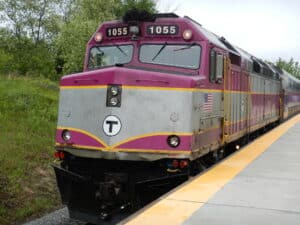
An MBTA commuter rail train waits at a station in 2019. The MBTA announced weekend service cuts beginning later this month. Photo by Paul Morris | Flickr / CC BY-SA 2.0
Swamped by all the gloomy coronavirus news and headlines, state transportation czarina Stephanie Pollack’s decision last week to damn the economic storm clouds and roll full steam ahead with construction of whole a new commuter rail line got short shrift.
But the impending launch of construction of the new South Coast line is good news, and not just for our beleaguered roads and highways which, short of a complete work-from-home revolution following the end of the COVID-19 epidemic, are likely to return to their old, traffic clogged ways.
Rather, the extension of commuter rail service to Southeast Massachusetts, extending all the way to Fall River and New Bedford, also provides a booster shot for the long-term health of the Greater Boston housing market, which has been chronically ill now for at least two decades.
90 Minutes to New Bedford
The new South Coast line and it’s 90-minute end-to-end journey will suddenly open up the region’s mix of outer suburbs, old industrial cities and rural towns – and their significantly lower home and condo prices – to buyers from across the Boston area.
And when it starts operations in 2023 it will also provide a badly needed boost new home, condo and apartment construction as land near the new commuter rail stops becomes available for development.
The MBTA’s Fiscal and Management Control Board’s decision last week to award the first major construction contract of the planned $1 billion rail line is a big step forward in this regard.
“Most people are not interested in making a trade-off that involves very long car rides into Boston. They don’t trade up on housing at the expense of trading down on their commute.”
— Peter Forman, president and CEO, South Shore Chamber of Commerce
Under the $159 million contract, Skanska and D.W. White Construction build two new commuter rail stations in Fall River and Freetown and retrofit more than 12 miles of freight rail lines to accommodate passenger trains.
Next up is a $400 million contract to extend commuter rail service to New Bedford. In late June, the MBTA’s fiscal management board will open construction bids for a contract to build four new stations in Middleborough, East Taunton, Church Street (formerly North New Bedford) and New Bedford and work on 24 miles of track.
Transit Draws Housing
The decision to forge ahead with the line drew praise from Peter Forman, president and CEO of the South Shore Chamber of Commerce, who has seen the power of public transit to spur new housing first-hand.
Quincy’s four Red Line stops have become a magnet for new development, with thousands of new apartments and condos taking shape near the city’s various T stations.
The rollout of the Greenbush commuter rail line from South Station down to Scituate a decade ago also spurred new residential construction, in particular in Weymouth.
“It starts to give Boston residents a chance to think ‘I can get into the suburbs and have a different quality of life,’” Forman noted. “Maybe I can have a bigger home, a bigger apartment, and now I can do mass transit.”
Old industrial cities on the comeback trail – or “Gateway Cities” in the parlance of economic development officials – New Bedford, Fall River and Taunton also boast some of the state’s lowest home prices.

The South Coast’s grueling traffic has kept the area out of bounds for many Greater Boston workers.
All three are well below the median single-family sale price for Massachusetts, which, at the end of March, stood at over $400,000, according to The Warren Group, publisher of this newspaper.
Taunton’s median weighed in at $331,500, New Bedford at $252,500, and Fall River at $290,000.
At $319,000, the median sale price for single-family homes in Bristol County is the lowest by far in Eastern Massachusetts, and well below the $560,000 of the western and northern suburbs of Middlesex Country and the $550,000 of Suffolk County, mainly Boston and its environs.
Train Beats Traffic
Sure, there was nothing stopping intrepid home buyers from the Boston area from attempting the commute previously – nothing, that is, but a grueling, two-hour, traffic–choked trip.
Trading cheap housing for a terrible commute is a deal few people have been historically willing to make.
“Most people are not interested in making a trade–off that involves very long car rides into Boston,” Forman said. “They don’t trade up on housing at the expense of trading down on their commute.”
The new commuter rail line is also likely to spur new housing construction as well, with Gateway Cities typically punching well above their weight when it comes to giving the green light to new home construction.

Scott Van Voorhis
Still, whether the new line will also spur new home and condo construction in some of the smaller, surrounding communities of Southeastern Massachusetts is another matter.
Given the zoning barriers many suburbs and towns across the state have used to severely limit or block new housing, it’s likely to be a tougher proposition.
But you have to start somewhere. And extending the commuter rail to Southeastern Massachusetts – and putting its more moderately priced homes within commuting reach of more struggling, middle-class families – is a good first step.
Scott Van Voorhis is Banker & Tradesman’s columnist; opinions expressed are his own. He may be reached at sbvanvoorhis@hotmail.com.




 |
| 

